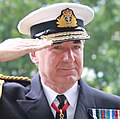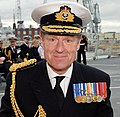| Fleet Commander | |
|---|---|
 Ensign of the Royal Navy | |
| Ministry of Defence Royal Navy | |
| Member of | Admiralty Board, Navy Board, Navy Command |
| Reports to | First Sea Lord |
| Nominator | Secretary of State for Defence, on advice from the Defence Council |
| Appointer | Prime Minister Subject to formal approval by the King-in-Council |
| Term length | Not fixed (typically 1–4 years) |
| Inaugural holder | Admiral George Zambellas |
| Formation | 2012 |
Fleet Commander is a senior Royal Navy post, responsible for the operation, resourcing and training of the ships, submarines and aircraft, and personnel, of the Naval Service. The vice-admiral incumbent is required to provide ships, submarines and aircraft ready for operations, and is based at Navy Command Headquarters.
Contents
- Responsibilities
- List of fleet commanders
- Fleet Commander
- Deputy Fleet Commander
- See also
- References
- External links
The post was created in April 2012 following a reorganisation of the Royal Navy and a re-designation of the former role of Commander-in-Chief Fleet. [1]






